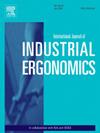肩部辅助外骨骼对在模拟桅杆攀爬器上完成铺块任务时的平衡和肌肉活动的影响
IF 2.5
2区 工程技术
Q2 ENGINEERING, INDUSTRIAL
International Journal of Industrial Ergonomics
Pub Date : 2024-10-02
DOI:10.1016/j.ergon.2024.103652
引用次数: 0
摘要
在其他行业取得令人鼓舞的成果的推动下,建筑工人对利用外骨骼减轻肌肉骨骼疾病(MSDs)风险的兴趣与日俱增。然而,在实施之前,仔细研究外骨骼对工人稳定性和平衡性的影响至关重要。在这项研究中,七名男性参与者在不稳定平台上使用三种不同的外骨骼模型,在肘部和肩部两个高度将 35 磅重的煤渣块从生产台上举到模拟墙上,并对他们的平衡和肩部肌肉活动进行了评估。与平衡相关的参数包括平均距离(MDIST)、总偏移量(EXCUR)和压力中心的平均速度(VEL),均来自力板数据。使用肌电图(EMG)数据估算了六块肩部和上臂肌肉的活动。结果表明,与不穿戴外骨骼相比,穿戴其中两个外骨骼会明显增加MDIST的总量和内外侧(ML)。穿戴其中一个外骨骼可明显增加总VEL、ML VEL和ML EXCUR。虽然举重水平对平衡参数没有明显影响,但它确实影响了大部分测量肌肉的活动。此外,与不使用外骨骼相比,只有一种外骨骼明显降低了特定肩部肌肉的活动。总之,所评估的肩部辅助外骨骼在预防上肢 MSD 方面的益处有限,而且可能会对在不稳定平台上进行砌块铺设任务时的全身平衡产生负面影响。这些发现强调了在建筑业采用外骨骼之前对其平衡性和有效性进行全面评估的重要性。本文章由计算机程序翻译,如有差异,请以英文原文为准。
Shoulder-assist exoskeleton effects on balance and muscle activity during a block-laying task on a simulated mast climber
Interest in utilizing exoskeletons to mitigate the risks of musculoskeletal disorders (MSDs) among construction workers is growing, spurred by encouraging results in other industries. However, it is crucial to carefully examine their impact on workers' stability and balance before implementation. In this study, seven male participants lifted a 35-lb cinder block from a production table to a simulated wall at two heights—elbow and shoulder levels—using three different exoskeleton models on an unstable platform, where their balance and shoulder muscle activity were assessed. Balance-related parameters, included mean distance (MDIST), total excursion (EXCUR), and mean velocity (VEL) of the center of pressure, were derived from force plate data. Muscle activity in six shoulder and upper arm muscles was estimated using electromyography (EMG) data. The results indicated that wearing two of the exoskeletons significantly increased both total and medio-lateral (ML) MDIST compared to not wearing an exoskeleton. Wearing one of the exoskeletons significantly increased total and ML VEL and ML EXCUR. Although lifting level did not have a significant impact on the balance parameters, it did affect the muscle activity in most of the measured muscles. Moreover, only one exoskeleton significantly reduced the activity in a particular shoulder muscle compared to no exoskeleton use. In conclusion, the evaluated shoulder-assist exoskeletons showed limited benefits for preventing upper extremity MSDs and may negatively affect whole-body balance during a block-laying task on an unstable platform. These findings underscore the importance of comprehensive evaluations of balance and effectiveness prior to adopting exoskeletons in construction.
求助全文
通过发布文献求助,成功后即可免费获取论文全文。
去求助
来源期刊
CiteScore
6.40
自引率
12.90%
发文量
110
审稿时长
56 days
期刊介绍:
The journal publishes original contributions that add to our understanding of the role of humans in today systems and the interactions thereof with various system components. The journal typically covers the following areas: industrial and occupational ergonomics, design of systems, tools and equipment, human performance measurement and modeling, human productivity, humans in technologically complex systems, and safety. The focus of the articles includes basic theoretical advances, applications, case studies, new methodologies and procedures; and empirical studies.

 求助内容:
求助内容: 应助结果提醒方式:
应助结果提醒方式:


